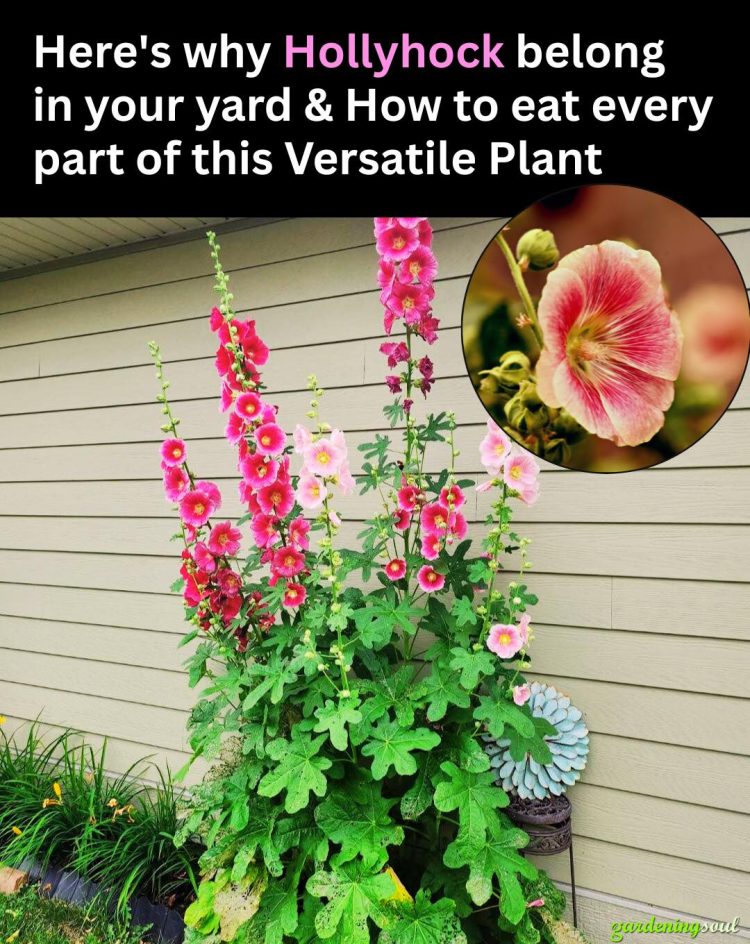3. Hollyhock Seeds
Hollyhock seeds form in small pods after flowering. They’re not commonly eaten but are non-toxic and can be used in some cultures for herbal remedies or flour blends.
Some herbalists grind dried seeds for digestive teas or mild laxative effects.
In survival settings, dried seeds may be powdered and added to flour mixes.
Always consult with an herbal expert before consuming seeds in large quantities.
4. Hollyhock Roots
The roots are mucilaginous and have long been used in folk medicine for coughs, sore throats, digestive issues, and skin irritations – similar to marshmallow root.
How to Use:
Decoction (root tea): Chop fresh or dried roots, simmer in water for 15–20 minutes, and drink for respiratory or stomach relief.
Poultices: Mash the root and apply to skin rashes, burns, or bites for soothing effect.
Syrup: Infuse with honey to create a natural throat-soothing syrup.
Use roots from plants older than 2 years for medicinal strength.
How to Grow Hollyhocks Successfully in Your Yard
Hollyhocks thrive in most temperate climates and are relatively forgiving once established.
Best Growing Conditions:
Requirement Ideal Conditions
Sunlight Full sun (6–8 hours daily)
Soil Loamy, well-draining, enriched with compost
Water Moderate, consistent moisture
Spacing 18–24 inches apart
Hardiness Zones USDA Zones 3–9
How to Start from Seed:
Sow in spring or fall, directly in the ground or in seed trays.
Lightly press seeds into soil but don’t cover heavily—they need light to germinate.
Keep soil moist until germination (usually 1–2 weeks).
Transplant when seedlings have 2–3 sets of true leaves.
Supporting Tall Growth:
Because hollyhocks can reach 6–8 feet tall, stake them or plant them near a wall or fence for support, especially in windy areas.
Dealing with Common Pests:
The most common hollyhock problem is rust fungus, a reddish-orange leaf spot caused by moisture.
Prevention Tips:
Space plants for good air circulation
Avoid overhead watering
Remove and destroy infected leaves early
Apply organic sulfur or neem oil as a natural antifungal
Traditional Herbal Uses of Hollyhock
In herbal medicine, hollyhocks have been used similarly to marshmallow root (Althaea officinalis). Key uses include:
Respiratory Health:
Tea from flowers and roots helps ease dry coughs and throat irritation.
Digestive Soothing:
The mucilage in leaves and roots coats the stomach lining, calming indigestion or heartburn.
Skin Care:
Poultices made from crushed leaves or roots help heal burns, rashes, and swelling.
Wound Healing:
Leaves and flowers can be steeped in oil for 2–3 weeks to make a healing salve for minor wounds.
Note: Always consult a healthcare professional before using hollyhock therapeutically, especially if pregnant or taking medications.
Fun Recipes Using Hollyhocks
1. Hollyhock Flower Tea
1 tbsp dried or 3 tbsp fresh petals
1 cup boiling water
Steep for 10 minutes, strain, sweeten with honey
2. Hollyhock Leaf Dolmas
Blanch young leaves
Fill with rice, herbs, and vegetables
Roll and bake with lemon-olive oil sauce
3. Hollyhock Syrup (for Sore Throats)
Simmer chopped roots in water for 30 mins
Add raw honey and simmer until thick
Cool and store in a glass jar
Safety Notes and Precautions
Pesticide Warning: Only consume hollyhocks grown organically or from untreated seed.
Allergy Alert: Though rare, mucilaginous plants can cause digestive upset in sensitive individuals.
Pregnancy: Consult a professional before consuming hollyhock root tea while pregnant.
Hollyhocks are more than just decorative. They’re part of a rich heritage of edible, medicinal, and ecological gardening, offering powerful benefits while bringing vertical beauty to your yard.
